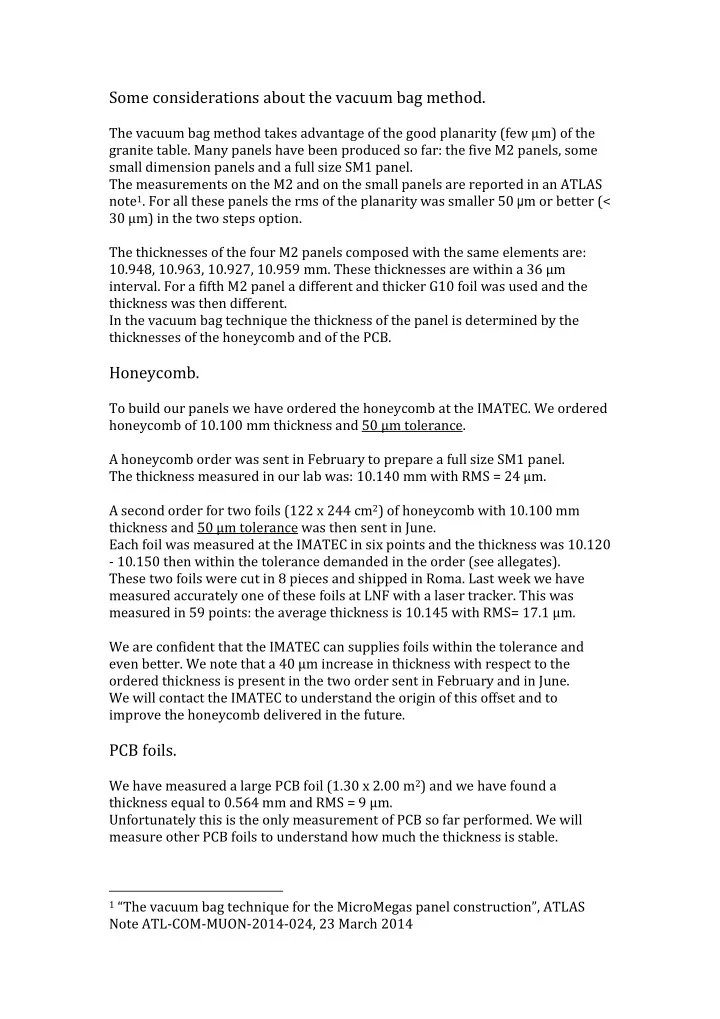

Some considerations about the vacuum bag method. The vacuum bag method takes advantage of the good planarity (few μm) of the granite table. Many panels have been produced so far: the five M2 panels, some small dimension panels and a full size SM1 panel. The measurements on the M2 and on the small panels are reported in an ATLAS note 1 . For all these panels the rms of the planarity was smaller 50 µ m or better (< 30 μm) in the two steps option. The thicknesses of the four M2 panels composed with the same elements are: 10.948, 10.963, 10.927, 10.959 mm. These thicknesses are within a 36 μm interval. For a fifth M2 panel a different and thicker G10 foil was used and the thickness was then different. In the vacuum bag technique the thickness of the panel is determined by the thicknesses of the honeycomb and of the PCB. Honeycomb. To build our panels we have ordered the honeycomb at the IMATEC. We ordered honeycomb of 10.100 mm thickness and 50 μm tolerance. A honeycomb order was sent in February to prepare a full size SM1 panel. The thickness measured in our lab was: 10.140 mm with RMS = 24 μm. A second order for two foils (122 x 244 cm 2 ) of honeycomb with 10.100 mm thickness and 50 μm tolerance was then sent in June. Each foil was measured at the IMATEC in six points and the thickness was 10.120 - 10.150 then within the tolerance demanded in the order (see allegates). These two foils were cut in 8 pieces and shipped in Roma. Last week we have measured accurately one of these foils at LNF with a laser tracker. This was measured in 59 points: the average thickness is 10.145 with RMS= 17.1 μm. We are confident that the IMATEC can supplies foils within the tolerance and even better. We note that a 40 μm increase in thickness with respect to the ordered thickness is present in the two order sent in February and in June. We will contact the IMATEC to understand the origin of this offset and to improve the honeycomb delivered in the future. PCB foils. We have measured a large PCB foil (1.30 x 2.00 m 2 ) and we have found a thickness equal to 0.564 mm and RMS = 9 μm. Unfortunately this is the only measurement of PCB so far performed. We will measure other PCB foils to understand how much the thickness is stable. 1 “The vacuum bag technique for the MicroMegas panel construction”, ATLAS Note ATL-COM-MUON-2014-024, 23 March 2014
Some comments. The vacuum technique used in Roma seems adequate and mature to produce panels with planarity at the level of about 30 μm RMS. In the last full size SM1 prototype (210 x 130 cm 2 ) glued in May, the thickness of the panel lying on the granite table measured for the two sides is: 11.466 mm with RMS = 32 μm and 11.434 mm with RMS = 36 μm. We intend to prepare new panels measuring the thicknesses of all the components and trying to understand how much we can be confident on the stability of the delivered components. In case of difficulties in the procurement of components with the demanded tolerance, we will consider the possibility to use a stiffback approach for the drift panel built in Roma. Of course this will happen only with the strong support of the groups able to realize stiffbacks with the planarity needed for the project.
Recommend
More recommend